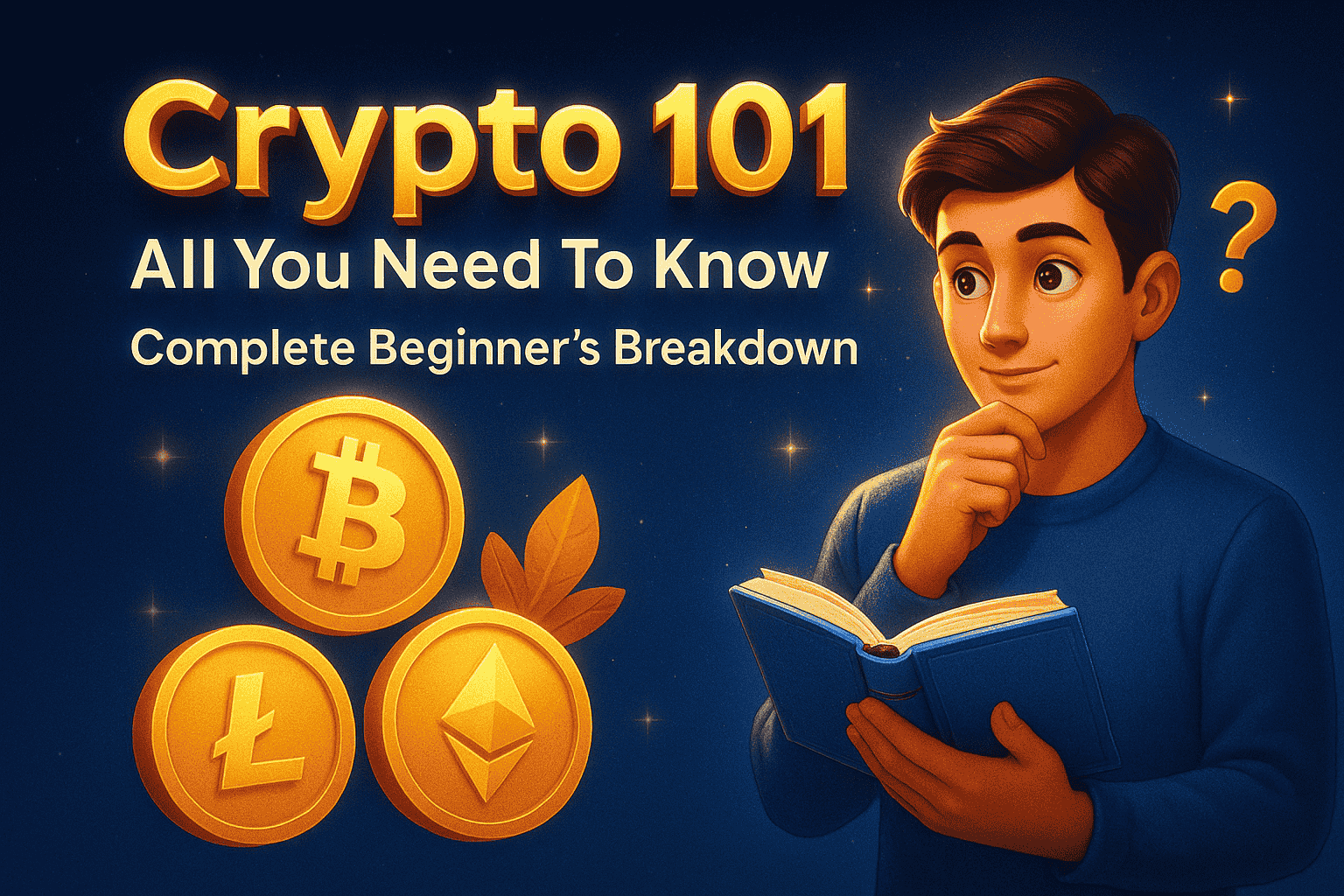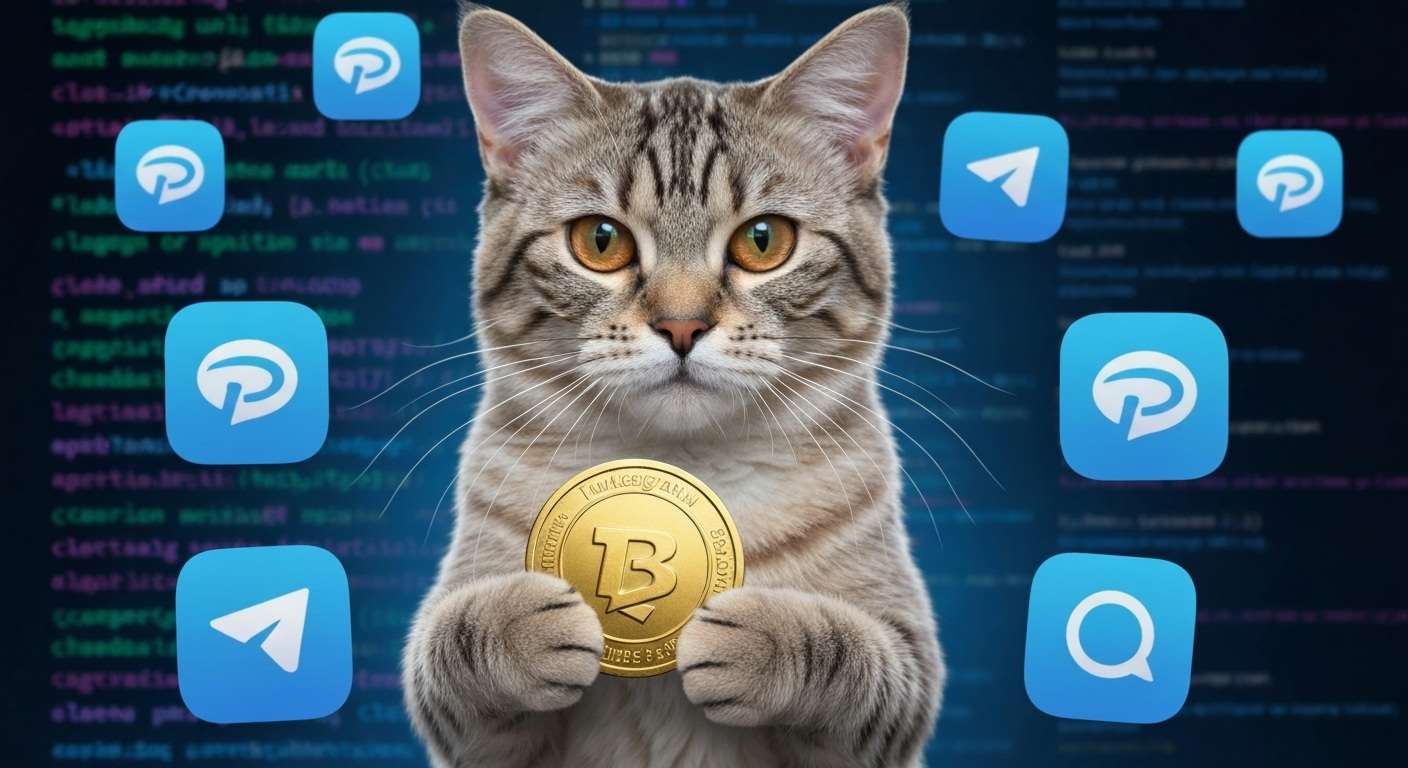Table of Contents
- 🔍 What Is Cryptocurrency? 💰
- 🏗️ What Is Blockchain? 🔗
- 📖 A Biblical Perspective on Blockchain & Cryptocurrency
- 🧬 Components of a Cryptocurrency System
- 🔐 Cryptographic Foundations
- 6️⃣ Types of Crypto Assets
- 💡 Real-World Applications of Cryptocurrency
- 🌍 Crypto and Web3
- 🧾 Common Terms Every Beginner Should Know
- 🧠 How Crypto Differs from Traditional Finance (TradFi)
- 🧯 Risks & Limitations of Crypto
- 📚 Recommended Resources to Learn Crypto
🔍 What Is Cryptocurrency? 💰
Cryptocurrency is a new kind of digital money 💸 — built for the internet 🌐, powered by blockchain technology 🔗, and secured through cryptography 🔒. It's designed to be decentralized 🏛️, meaning no single government or bank controls it. Instead, it runs on a network of computers around the world 🌎 — making transactions fast, transparent, and borderless ✈️.
Unlike traditional money, crypto is peer-to-peer 🤝 — you can send it directly to anyone, anywhere, without needing a bank. Each transaction is recorded on a permanent public ledger called the blockchain 📘, which anyone can verify. This makes crypto highly secure 🛡️ and nearly impossible to tamper with.
Most cryptocurrencies like Bitcoin (BTC) or Ethereum (ETH) have a limited supply 🔢, which gives them scarcity — a key reason many people view them as digital gold. To use or store crypto, you’ll need a digital wallet 🎒 — this can be a mobile app 📱, a web platform 🌐, or even a physical device 🔐.
“Cryptocurrency isn’t just about money — it’s about freedom, ownership, and rewriting the rules of the financial system.” ⚡
Whether you're curious about blockchain, exploring digital assets, or just wondering how crypto works — this new financial frontier is reshaping how we think about money 💡. Keep learning 📚, stay safe 🛑, and enjoy the journey into decentralized finance 🚀.
🏗️ What Is Blockchain? 🔗
Blockchain is the groundbreaking technology that powers cryptocurrencies like Bitcoin and Ethereum. At its core, a blockchain is a distributed digital ledger 📒 that records transactions in a secure, transparent, and tamper-proof way.
Imagine a notebook 📓 that is duplicated across thousands of computers 🌍 — and every time a transaction is made, it’s added as a new “block” ⬛ to the notebook. Each block is linked (or “chained”) to the previous one using cryptographic hashes 🔐 — creating an unbreakable chain of records. This is why it's called a blockchain.
Every participant in the network holds a copy of this ledger 🧾, which makes blockchain incredibly transparent 👁️ and almost impossible to corrupt 🛡️. Once data is written to the blockchain, it’s immutable — meaning it cannot be changed or deleted ✋. This ensures high levels of security 🔒 and trust between parties — without needing a middleman like a bank or notary.
💎 Key Features of Blockchain:
- 📖 Transparency: Every transaction is visible to all participants in the network.
- 🛑 Immutability: Once data is recorded, it cannot be altered or deleted.
- 🔐 Security: Encrypted and decentralized, making it highly resistant to fraud or hacking.
🧬 Types of Blockchains:
- 🌐 Public Blockchain: Open to everyone. Anyone can participate, validate, and view the data. Examples: Bitcoin, Ethereum.
- 🏢 Private Blockchain: Controlled by a single organization or group. Access is restricted. Common in enterprise use. Example: Hyperledger Fabric.
- 🤝 Consortium Blockchain: Semi-decentralized. Managed by a group of organizations working together. Example: Quorum (developed by JPMorgan Chase).
“Blockchain is more than just technology — it’s a trust machine that removes the need for intermediaries and puts power back into the hands of people.” 🌍
Whether it’s tracking financial transactions, managing supply chains 📦, authenticating digital identities 🧑💼, or securing health records 🏥 — blockchain is revolutionizing how we store and share information. It's the foundation that makes cryptocurrencies possible, and its potential goes far beyond just digital money 💡.
As you explore crypto, understanding blockchain is like learning how the internet works behind your favorite apps — it's the invisible engine 🔧 that keeps everything running smoothly. Stay curious, keep digging, and you’ll uncover a whole world of decentralized innovation 🚀.
📖 A Biblical Perspective on Blockchain & Cryptocurrency
As we navigate this digital shift in finance, it’s vital to ground our understanding in God’s unchanging Word 🕊️. Cryptocurrency and blockchain technology may feel futuristic, but the values behind them — transparency, fairness, accountability — deeply align with biblical principles.
Blockchain offers a transparent and immutable record of truth 🔍 — echoing God’s call for honesty in every transaction. Proverbs 11:1 tells us, “The LORD detests dishonest scales, but accurate weights find favor with him.” ⚖️ In a world plagued by manipulation, blockchain creates a system where truth is built into the foundation of the network itself.
Furthermore, decentralization reflects biblical models of shared responsibility and stewardship. In Exodus 18:21, Moses was instructed to appoint capable leaders to share the burden of leadership — a principle mirrored in how blockchain removes power from a single authority and distributes it among participants 🤝.
“So if you have not been trustworthy in handling worldly wealth, who will trust you with true riches?” – Luke 16:11 📜
As believers, we’re called to be wise stewards of our finances and decisions. Cryptocurrency is not inherently good or evil — it’s a tool 🔧. The key is how we use it. 1 Corinthians 10:31 reminds us, “So whether you eat or drink or whatever you do, do it all for the glory of God.” 🙌
💡 Faith-Driven Finance in a Digital World
Approaching crypto with prayer, wisdom, and discernment allows us to harness innovation without compromising conviction. As the financial landscape evolves, let’s be people of integrity, generosity, and purpose — using every opportunity to reflect the Kingdom of God 🌍.
🧬 Components of a Cryptocurrency System
A cryptocurrency ecosystem is made up of several essential components that work together to make decentralized finance possible 🔗. Understanding these parts helps you see how blockchain-based systems operate — from storing assets to verifying transactions. Let’s break them down with simple examples 👇
🧑💻 Nodes
Nodes are individual computers connected to a blockchain network. They maintain copies of the blockchain and help keep the system decentralized and secure. Some nodes are just observers, while others help verify transactions ✅.
Example: A laptop running Bitcoin Core software acts as a node and stores the full Bitcoin ledger.
⛏️ Miners / Validators
These are specialized nodes that validate and add new transactions to the blockchain. In proof-of-work (e.g., Bitcoin), they solve complex puzzles. In proof-of-stake (e.g., Ethereum 2.0), validators are chosen based on how much crypto they “stake” (lock up) as collateral.
Example: A Bitcoin mining rig using ASIC hardware to earn BTC, or an Ethereum validator running staking software to earn ETH rewards.
👛 Wallets
Wallets store your crypto’s public and private keys — think of them like digital safes 🔐. They don’t store the coins themselves but allow you to send, receive, and access your assets on the blockchain.
Example: MetaMask (browser wallet), Trust Wallet (mobile), Ledger Nano X (hardware wallet).
🤖 Smart Contracts
These are self-executing pieces of code stored on the blockchain. They trigger actions automatically when conditions are met — no middlemen needed 🤝.
Example: A DeFi lending app where a smart contract automatically releases funds when collateral is provided (e.g., Aave or Compound).
💡 Together, these components form the backbone of every crypto network — enabling trust, automation, and control in the hands of the users, not institutions.
🔐 Cryptographic Foundations
At the heart of every cryptocurrency is powerful cryptography 🧠🔒. It’s what makes crypto secure, decentralized, and tamper-proof. Let’s explore the core elements of these digital defenses.
🔁 Hash Functions
A hash function takes any input and produces a fixed-length string — like a fingerprint for data. It's one-way, meaning you can't reverse it to find the original input. Bitcoin uses SHA-256, a secure hashing algorithm.
Example: The Bitcoin block #800000 has a unique SHA-256 hash: 00000000000000000005b75e9b46ec...
🔑 Public/Private Key Cryptography
This is how wallets and transactions work securely. Each wallet has a public key (your address) and a private key (your secret password). The private key is used to sign transactions — proving ownership without revealing your identity 👤.
Example: When Alice sends BTC to Bob, she uses her private key to sign the transaction, and Bob receives it at his public key address.
✍️ Digital Signatures
Every crypto transaction is signed with a digital signature. It confirms that the sender is legitimate and the message hasn’t been tampered with 📜.
Example: Ethereum uses ECDSA (Elliptic Curve Digital Signature Algorithm) to verify each transaction on the network.
⚙️ Consensus Mechanisms
These are the rules that allow decentralized nodes to agree on the state of the blockchain. No central authority — just math, code, and honesty incentives 🧩.
- 🛠️ Proof-of-Work (PoW): Miners solve puzzles to earn the right to validate blocks. Used by Bitcoin.
- 💎 Proof-of-Stake (PoS): Validators stake coins and are selected to create new blocks. Used by Ethereum 2.0.
- 🧠 Delegated Proof-of-Stake (DPoS): Token holders vote for trusted delegates who validate blocks. Used by EOS.
- 🪪 Proof-of-Authority (PoA): A few known, trusted validators manage the chain. Common in private blockchains.
- ⏳ Proof-of-History (PoH): Adds timestamps to transactions, proving when events occurred. Used by Solana.
Example: Bitcoin miners compete to solve a cryptographic puzzle every 10 minutes.
Example: Staking 32 ETH allows you to run a validator node on Ethereum.
Example: In EOS, token holders elect 21 block producers to maintain the blockchain.
Example: VeChain uses PoA for faster, enterprise-friendly transactions.
Example: Solana achieves high throughput by sequencing transactions using PoH.
💡 These cryptographic tools are what make crypto tick — from secure wallets to global consensus, it’s all powered by invisible math and code. Mastering these basics helps you see why blockchain is so revolutionary 🔓🌍.
Consensus Mechanism Comparison
| Mechanism | Used By | Security | Energy Efficiency | Scalability |
|---|---|---|---|---|
| Proof-of-Work (PoW) | Bitcoin, Litecoin | 🔒 Very High | 🔋 Low | ⚖️ Low |
| Proof-of-Stake (PoS) | Ethereum 2.0, Cardano | 🔒 High | 🔋 High | ⚖️ Moderate |
| Delegated PoS (DPoS) | EOS, TRON | 🔒 Moderate | 🔋 High | ⚖️ High |
| Proof-of-Authority (PoA) | VeChain, private chains | 🔒 Moderate | 🔋 Very High | ⚖️ Very High |
| Proof-of-History (PoH) | Solana | 🔒 High | 🔋 High | ⚖️ Very High |
💡 Understanding these mechanisms is crucial for grasping how different cryptocurrencies operate and their potential impact on the future of finance. As you explore crypto, keep these principles in mind to navigate the landscape with confidence and wisdom.
6️⃣ Types of Crypto Assets
In the world of cryptocurrency, not all digital assets are created equal. There are several types of crypto assets, each serving different purposes in the blockchain ecosystem. Let’s break them down:
💰 Coins vs. Tokens
- Coins: These operate on their own native blockchain. They serve primarily as digital money or a store of value.
- Tokens: These are built on existing blockchains and can serve a variety of functions beyond just money.
Examples: Bitcoin (BTC), Ethereum (ETH), Litecoin (LTC)
Examples: Uniswap (UNI), Chainlink (LINK), Shiba Inu (SHIB) — all running on Ethereum's blockchain.
📂 Categories of Tokens
- Utility Tokens: Provide access to a product or service within a blockchain ecosystem.
- Governance Tokens: Grant holders voting rights on platform decisions and proposals.
- Security Tokens: Represent ownership in real-world assets like stocks or real estate and are regulated by securities laws.
- Stablecoins: Pegged to stable assets (like USD) to minimize volatility.
Example: Chainlink (LINK) — powers smart contracts by delivering real-world data.
Examples: Uniswap (UNI), Aave (AAVE)
Example: tZERO — a tokenized security offering regulated investment opportunities.
Examples: Tether (USDT), USD Coin (USDC), DAI
🧠 Understanding the distinctions between coins and various token types is key to navigating the crypto landscape effectively and responsibly.
💡 Real-World Applications of Cryptocurrency
Cryptocurrency isn’t just a buzzword — it’s a powerful technology reshaping the world around us 🌍. From finance to art, gaming to governance, crypto is creating new ways for people to interact, transact, and trust each other in a digital age. Here's how:
- 💸 Payments and Remittances: Crypto enables fast, low-cost global money transfers — no banks, no borders, just peer-to-peer freedom.
- 🏦 DeFi (Decentralized Finance): Access financial services like lending, borrowing, and earning interest — without intermediaries.
- 🎨 NFTs (Non-Fungible Tokens): Digital ownership of unique assets — art, music, collectibles — all secured on the blockchain.
- 🏛️ DAOs (Decentralized Autonomous Organizations): Online communities that make decisions collectively using smart contracts and governance tokens.
- 🚚 Supply Chain Management: Blockchain brings transparency and traceability to supply chains, reducing fraud and waste.
- 🎮 Gaming and the Metaverse: Players earn and trade in-game assets with real-world value, while owning their digital identity.
- 🛂 Cross-Border Identity & Verification: Blockchain can store verifiable credentials, empowering individuals in areas without traditional ID systems.
Example: A freelancer in Nigeria receives Bitcoin from a client in Canada within minutes, avoiding bank delays and high fees.
Example: Users stake crypto in platforms like Aave or Compound to earn passive income or take out loans.
Example: Artists mint their work as NFTs on platforms like OpenSea and earn royalties every time it’s resold.
Example: A community of developers funds open-source tools via DAO proposals voted on by token holders.
Example: Retailers track products from farm to shelf using platforms like VeChain.
Example: In Axie Infinity or Decentraland, users buy land, breed characters, and trade NFTs for crypto rewards.
Example: Projects like KILT Protocol or Worldcoin are exploring decentralized identity solutions worldwide.
🚀 Crypto isn’t the future — it’s happening now. As the technology matures, its impact will only deepen. Keep exploring, stay informed, and embrace this exciting shift responsibly 🙌.
🌍 Crypto and Web3
Welcome to Web3 — the next evolution of the internet, where power shifts from centralized giants to the people 🌐. Unlike Web2 (think Google, Facebook), Web3 runs on blockchain technology, giving users control over their data, identity, and digital assets.
🔑 Definition of Web3: A decentralized version of the internet, built on blockchain and smart contracts, enabling users to own and interact with digital assets without intermediaries.
🧠 Wallets as Digital Identities
In Web3, your crypto wallet is more than a place to store coins — it’s your identity across the decentralized web 💳.
Example: With a wallet like MetaMask, you can log into dApps, vote in DAOs, mint NFTs, or verify your identity — all without a traditional username or password.
📱 dApps (Decentralized Applications)
dApps are apps built on blockchain networks that run without centralized servers. They offer transparency, censorship resistance, and user ownership.
Example: Uniswap is a decentralized exchange (DEX) that lets users swap tokens directly from their wallets, with no central authority controlling trades.
🎯 With Web3, you’re not just a user — you’re a participant and stakeholder. As we move into this decentralized future, wallets, dApps, and crypto will empower people everywhere to take control of their digital lives 🚀.
🧾 Common Terms Every Beginner Should Know
Diving into the crypto space? 🚀 Here's a numbered glossary of essential terms to help you navigate this exciting new world with confidence and clarity 🧠:
- 🔑 Private Key: A secret cryptographic code used to sign transactions and access your crypto. Never share it!
- 🔐 Public Key: A code derived from your private key, used to generate your wallet address.
- 📬 Address: A unique string of characters that represents your wallet (like your bank account number).
- ⛽ Gas Fees: Transaction fees paid to miners/validators to process operations on blockchains (especially Ethereum).
- #️⃣ Hash: A fixed-length string produced by a hash function (e.g., SHA-256) that uniquely represents data.
- 📚 Ledger: A digital record of all blockchain transactions.
- 📏 Block Height: The number of blocks preceding a specific block in the blockchain.
- 🪓 Fork: A change to a blockchain’s protocol. Hard forks create a new chain; soft forks are backward-compatible.
- 🏗️ Layer 1: The base blockchain (e.g., Bitcoin, Ethereum).
- 🧱 Layer 2: Scaling solutions built on top of Layer 1s to improve speed and reduce gas fees (e.g., Arbitrum, Optimism).
- 🔗 On-chain: Transactions and data recorded directly on the blockchain.
- 📁 Off-chain: Data handled outside the blockchain to save space and improve performance.
- 🎮 NFT (Non-Fungible Token): A unique digital asset used in art, gaming, and collectibles.
- Token: A digital asset created on an existing blockchain (e.g., ERC-20 on Ethereum).
- 📡 Node: A computer connected to a blockchain network that verifies and stores data.
- 🧮 Smart Contract: A self-executing agreement stored on the blockchain.
- 👥 DAO: A Decentralized Autonomous Organization governed by community votes and smart contracts.
- 💵 Stablecoin: A crypto asset pegged to a stable asset (e.g., USDT, USDC).
- 📉 Volatility: The degree of price fluctuation in a crypto asset.
- 🌐 dApp: Decentralized application that runs on a blockchain (e.g., Uniswap, Aave).
📘 These are just a few of the many terms you'll come across in the world of crypto. There’s a whole universe of concepts waiting to be explored as you dive deeper into this space. Keep learning, stay curious, and enjoy the journey! 🚀
🧠 How Crypto Differs from Traditional Finance (TradFi)
Cryptocurrency isn't just a new kind of money — it’s a complete shift in how financial systems operate 🌍. Let’s break down the key differences between Crypto and Traditional Finance (TradFi) 🔍:
Crypto vs. TradFi Comparison
| Feature | Crypto | TradFi |
|---|---|---|
| Trust Model | 🔐 Trustless (code-based, transparent) | 🏛️ Trusted (banks, intermediaries) |
| Control | 🌐 Decentralized (no single authority) | 👮♂️ Centralized (governments, banks) |
| Access | 🌍 Borderless (anyone with internet) | 📍 Restricted by geography & ID requirements |
| Availability | ⏰ 24/7 global markets | 🕒 Business hours only, closed on holidays |
| Transaction Speed | ⚡ Fast (minutes or seconds) | 🐢 Slow (hours or days) |
| Transparency | 🔎 Open-source, publicly auditable | 🔒 Opaque systems, limited access |
| Fees | 💸 Low (varies by network) | 💰 Often high (hidden or fixed) |
Crypto flips the script by replacing middlemen with technology, giving power back to the individual 💪. It's not about replacing banks overnight — it’s about creating a parallel system where freedom, transparency, and global access are the new norm 🌐.
🧯 Risks & Limitations of Crypto
While cryptocurrency opens up incredible opportunities 🌐, it also comes with its fair share of challenges 🚧. Here’s what every beginner should be aware of:
- 📉 Volatility: Crypto prices can swing wildly within minutes. This makes it exciting but risky for those not prepared for sudden losses or gains.
- 🚨 Scams and Rug Pulls: From fake projects to pump-and-dump schemes, the crypto space has its share of bad actors. Always DYOR (Do Your Own Research).
- ⚖️ Regulation Uncertainty: Global governments are still figuring out how to regulate crypto. This creates legal ambiguity that can impact platforms and users overnight.
- 🌍 Environmental Impact: Proof-of-Work (PoW) networks like Bitcoin consume significant energy. Though newer systems like Proof-of-Stake (PoS) aim to solve this, sustainability remains a concern.
- 🧩 UX Complexity: Crypto wallets, keys, and DApps can be intimidating for non-tech users. One wrong step (like losing your private key) could mean losing your funds forever.
Despite these limitations, awareness and education are your best tools 🔑. By staying informed and cautious, you can explore crypto responsibly and securely 🌟.
📚 Recommended Resources to Learn Crypto
Ready to go deeper into the world of crypto? 🧠 Here are some trusted resources that will help you continue your journey with confidence and clarity:
🕮 Books
| Title | Author | What You'll Learn |
|---|---|---|
| The Bitcoin Standard | Saifedean Ammous | History of money and why Bitcoin matters |
| Mastering Bitcoin | Andreas Antonopoulos | Technical deep dive into how Bitcoin works |
| The Infinite Machine | Camila Russo | The story behind Ethereum’s creation |
🌐 Websites
| Platform | Focus Area |
|---|---|
| CoinDesk | Crypto news & analysis |
| Cointelegraph | Blockchain trends & educational articles |
| Binance Academy | Crypto fundamentals & tutorials |
| Ethereum.org | Official Ethereum guides & documentation |
📺 YouTube Channels
| Channel | What It Covers |
|---|---|
| Whiteboard Crypto | Visual breakdowns of crypto concepts |
| Finematics | DeFi and blockchain animations |
| Dapp University | Smart contract development & dApps |
🎧 Podcasts
| Podcast | Host(s) | Topic |
|---|---|---|
| Unchained | Laura Shin | Deep interviews with crypto leaders |
| Bankless | Ryan Sean Adams & David Hoffman | Decentralized finance and Web3 trends |
🌟 Final Thoughts
Crypto is more than just an asset class — it's a movement reshaping how we think about trust, value, and freedom 🌐. With the right knowledge and mindset, you can navigate this world with wisdom and purpose. Keep asking questions, stay curious, and explore responsibly 🔐. Your crypto journey has only just begun 🚀.
Thank you for reading! If you found this article helpful, please share it with others who might benefit. And remember, your journey is just beginning. Stay curious, stay faithful, and keep shining your light! ✨














